Feb-21-23
 | | Honza Cervenka: 9.c3 is not particularly good continuation, as black can play without fear 9...Nxe5!, and if white continues with 10.Re1 d5 11.f3, then black can play simply 11...c5 12.fxe4 cxd4 13.cxd4 Bg4, or he can try a bit more complex but perfectly sound 11...f5!! 12.fxe4?! fxe4! 13.Rf1 Bg4 14.Rxf8+ Qxf8 15.Qf1 Qxf1+ 16.Kxf1 Rf8+ 17.Kg1 c5 winning the piece back with huge advantage. Taking of the Pawn on e5 after 9...Nc5 10.Bc2 was on the other hand a serious mistake. 10...d6 would have been better. Tarrasch's 11.Qh5! Ng6 12.f4! gives white practically decisive advantage. |
|
Sep-11-23
 | | KEG: A rarity for the first decade of the 20th century: a game said to be won through opening preparation. If the stories about this game recounted in the tournament book are true, Tarrasch along with other players the day before this game were examining the consequences of 9. c3 Nc5 10. Bc2 Nxe5 at "the cafe" and concluded that Black was lost after 10...Nxe5 while Wolf was "unaware" of this pre-game analysis. As we will see, and as <Honza Cervenka) has indicated on this site, the merits of the moves preceding 10...Nxe5 are more complicated than Bachmann and Hoffer presented in the Tournament Book. Incidentally, this was the first encounter between Tarrasch and Wolf. They played ten more times between the time of this game and the early 1920's. Though Wolf was a strong player, and though he began playing Tarrasch at the time the latter's powers began to decline, Wolf never succeeded in winning even a single game against Tarrasch. 1. e4 e5
2. Nf3 Nc6
3. Bb5 a6
4, Ba4 Bf6
5. d4

click for larger viewThis move is long since out of favor, but it was popular at Monte Carlo 1902 (played four times including this game) and objectively is sound and arguably a decent alternative to the more normal (today) 5. 0-0. 5... exd4
6. 0-0 Be7

click for larger view7. e5
This and the sounder 7. Re1 are the usual lines here. The text leads to much sounder play and sets up some of the fireworks to follow. Given Tarrasch's style, he likely did subject the text to serious analysis before trying it against a strong opponent such as Wolf. 7... Ne4
8. Nxd4
The simpler 8. Re1 is what I would have expected from Tarrasch had he not closely considered the consequences of the text the day before. 8... 0-0
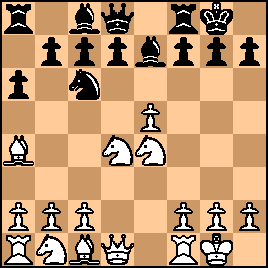
click for larger view9. c3?
So far as I am aware, <Honza Cervenka> was the first to recognize the flaws in this move. Tarrash should just have settled for 9. Re1 leaving an interesting unbalanced game with chances for both sides. According to Hoffer and Backmann in the Tournament Book, Tarrasch's idea here was to prepare to retreat the a4 Bishop to c2. But there is a simple refutation, the position now being: 
click for larger viewAs <Honza Cervenka> has shown, 9...Nxe5 gives Black much the better game. But Wolf, instead, played the move Tarrasch expected: 9... Nc5?
10. Bc2
Now White is fine, and arguably a little better: 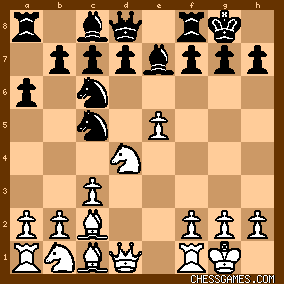
click for larger viewNow came the moment for which Tarrasch was fully prepared. |
|
Sep-13-23
 | | KEG: Post II
10... Nxe5?
This--as everybody has said and as Tarrasch had analyzed before the game--is a serious mistake. Wolf, though giving away his edge on his 9th move, would nonetheless have been fine with 10...d6 (the move recommended by <Honza Cervenka>). According to the Tournament Book, Wolf was lost after 10...Nxe5, after which "every one of Black's moves is forced..." and despite the valiant efforts of Wolf in offering the "best defense" from this point on. Hogwash!
It is far from clear that Tarrasch, even after winning material as a result of Wolf's error, had a won game, and it is certain that Wolf's play from this point on was weak. But let's see. After 10...Nxe5? the position was: 
click for larger view11. Qh5!
"!"--(<Honza Cervenka>) As pointed out by Hoffer an Bachmann, 11. Bxh7+ would be weak: 11...Kxh7 12. Qh5+ Kg8 13. Qxe5 Re8 and suddenly all the chances lie with Black. By contrast after Tarrasch's excellent pre-planned 11. Qh5, the position was: 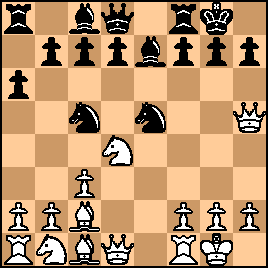
click for larger view11... Ng6?
Contrary to what was suggested in the Tournament Book, this was not "forced" but was rather a mistake that placed Wolf at further risk. Correct was 11...Ned3 12. b4 [best] g6 [pretty much forced] 13. Qf3 [or 13. Qd1 NxB 14. bxN Nxa2 15. Nb3 (better than 15. RxN Bxc5) d6 16. cxd6 Qxd6 17. Rxa2 leaving Black with two pawns for the lost piece but with chances of counter-play with his two Bishops] 13...NxB 14. bxc5 Nxa2 15. Nb3 a5 16. RxN a4 with two pawns plus solid counter-play for the lost piece. Plainly, Wolf was far from lost before his lemon on move 11. 12. f4!
"!"--(<Honza Cervenka>) "...gives white practically a decisive advantage." (<Honza Cervenka>) Tarrasch's 12. f4 was indeed best and very strong. But is Black truly lost yet? 
click for larger view12... Ne6?
"Black no longer has a reasonable defense." (Hoffer/Bachmann) Wolf was indeed likely lost after 12...Ne6, but how about 12...f5...Black might still have considerable play after 13. Nxf4 d6 14. Nd4 (best) [or 14. NxB+ QxN] Bf6 15. Be3 leaving White clearly better but--so far as I can see--far from a won game. Another improvement on Wolf's play would be 12...d5 13. f5 [else White is worse] Ne4 14. fxN fxg6 15. RxR+ BxR again leaving Black with two pawns for the lost piece but with decent chances for counter-play. After the text, Tarrasch tore the guts out of Wolf's position: 13. f5! NxN
14. cxN
Leaving Wolf in a wretched position:

click for larger viewAs I will discuss in my next post on this game, Wolf's weak play continued from here until he was utterly crushed by move 20. (How and why the game went on for another 32 moves after that need also be considered, as I will try to do). |
|
Sep-14-23
 | | KEG: Post III
14... Bf6
Black must lose a piece. As Hoffer and Bachmann pointed out, if instead 14...Nh8 Black would get crushed by 15. f6. 15. fxN Bxd4+?
Very weak. Wolf's best and perhaps only chance lay in 15...hxg6, though even then Tarrasch would have an extra Knight for two pawns (two of them doubled). After the text, Black was on the verge of defeat. 16. Kh1 hxg6
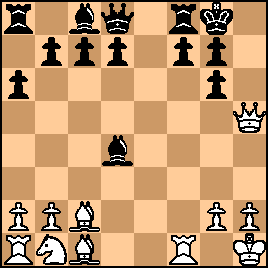
click for larger view17. Bxg6!
Wolf apparently missed this powerful move. And 17. Qd5 would also seemingly win for White. 17... fxg6
18. Qd5+
Winning back the piece (and again winding up a piece ahead for two pawns). 18... Kh7
19. RxR QxR
20. Qxd4
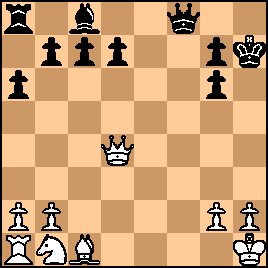
click for larger viewAlthough the only White pieces who have left their original squares are the Queen and the castled King, White's extra piece nearly assures his victory. In any case, a probably shell-shocked Wolf now seemed to collapse: 20... d5?
Almost anything (e.g., 20...Qf1+; 20...b5; 20...b6) would have been better. 21. Nd2
Meanwhile Tarrasch went about the business of developing his pieces and wrapping up his victory (or so it seemed at this point): 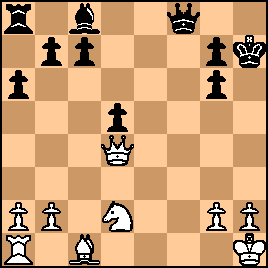
click for larger view21... Be6?
Another lemon by Wolf. He had nothing better than 21...Qf6 22. Qxd5 Bf5 23. Nf3, which would also have left him hopelessly lost. The text, however, was even worse: 22. Nf3

click for larger viewGame over, though Tarrasch took forever to end Wolf's resistance, as we will see. 22... c5?

click for larger viewThis desperate ploy should have allowed Tarrasch to conclude the game in short order. Tarrasch could have simply played 23. Qh4+ Kg8 24. Be3. But, beginning here, Tarrasch--who could usually be counted on to have ample technique to wrap up such a winning position--began to make heavy weather of the game, which now became needlessly extended for another 30 move. |
|
Sep-15-23
 | | KEG: Post IV
23. Ng5+
There were more brutal ways to punish Wolf's last move (most notably 23. Qh4+ Kg8 24. Be3). But Tarrasch's method here was entirely logical and understandable. He forces reduction to an endgame in which he an extra Bishop and therefore a theoretically easy win. This all went as planned, and may have avoided needless time-trouble with the looming 30-move time control: 23... Kg8
Anything else leads to mate.
24. NxB cxQ
25. NxQ RxN

click for larger viewThis looks pretty straightforward, especially from so fine a technician as Tarrasch. But he had blown what should have been an easily won piece up ending against Marshall in Round 2 of this tournament--based on his comments after his next-round game--may have been uncertain of himself in this his first important tournament in four years. In any case, if the reported score is correct (which I question) Tarrasch experienced undue trouble in finishing off this win against Wolf. 26. Kg1
Not truly a mistake, but awfully slow. 26. Bd2 (developing his pieces at long last) was natural and better. 26... Rc8
Wolf seized his chance at counter-play. It wasn't enough to save the game, but it apparently gave Tarrasch some anxious moments. 27. Bf4 Rc2

click for larger view28. Rd1
In his zeal to offer a Rook trade, Tarrasch missed the simpler 28. b4, making his take more difficult. 28... Rxb2
29. Rd2 Rb4
Trading Rooks would obviously have been bad for Black. 30. Be5

click for larger view30... Kf7
Black is still lost, but now he could make Tarrasch's task more onerous. 31. Bxd4 g5
He might have considered 31...Ra4, but the text was a decent attempt to stir the pot: 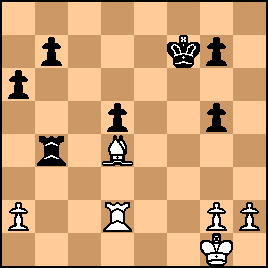
click for larger view32. Kf2
32. a3 or 32. Bc5 look simpler. But the more cumbersome text did not truly ruin anything. 32... b5
32...Ra4 might have been a better practical chance. The text left: 
click for larger view |
|
Sep-16-23
 | | KEG: Post V
We know there is SOMETHING wrong with the end of the score. It breaks off after Tarrasch's supposed 37th move and then says the game continued through move 52. Thus, at a minimum there are about 15 moves by both sides missing. In addition, as I will discuss, the score that comes down to us has Wolf hanging his g7 pawn repeatedly and Tarrasch ignoring it without any comment about this by Hoffer/Bachmann in their notes in the Tournament Book. None of this may matter, since Tarrasch retains his won game throughout. But I cannot believe that the remaining moves in the score can all be a correct account of what was actually played: 33. Ke2
Not awful, but hardly the fastest way to wrap up the game. 33... Ke6?

click for larger viewWhy hang a pawn instead of trying for counter-play with 33...Ra4? 34. Kf3
A strong move, but why not grab the g7 pawn?
34... Kf5
Again leaving the pawn en prise.
35. g4+
A reasonable choice, but why not simply 35. Bxg7? 35... Ke6
Here, 35...Kf7 to guard the g7 pawn would run into 36. Be3. But now, yet again, the pawn is hanging: 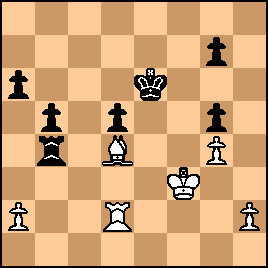
click for larger view36. Re2+
Tarrasch here had two crushing moves: 36. Be3 or 36. Bxg7. But the game score has him playing the text. 36... Kd6?
And why not 36...Kf7 here?
37. Be3
White is still winning after this move, but clearly stronger and faster were 37. Bxg7 or 37. Be5+ (and then probably 38. Bxg7. After the text, Tarrasch was still clearly winning, but no closer to finishing off his opponent: 
click for larger viewHere the score breaks off and we are told that Tarrasch won on move 52. Very strange. |
|
|
|
|





































